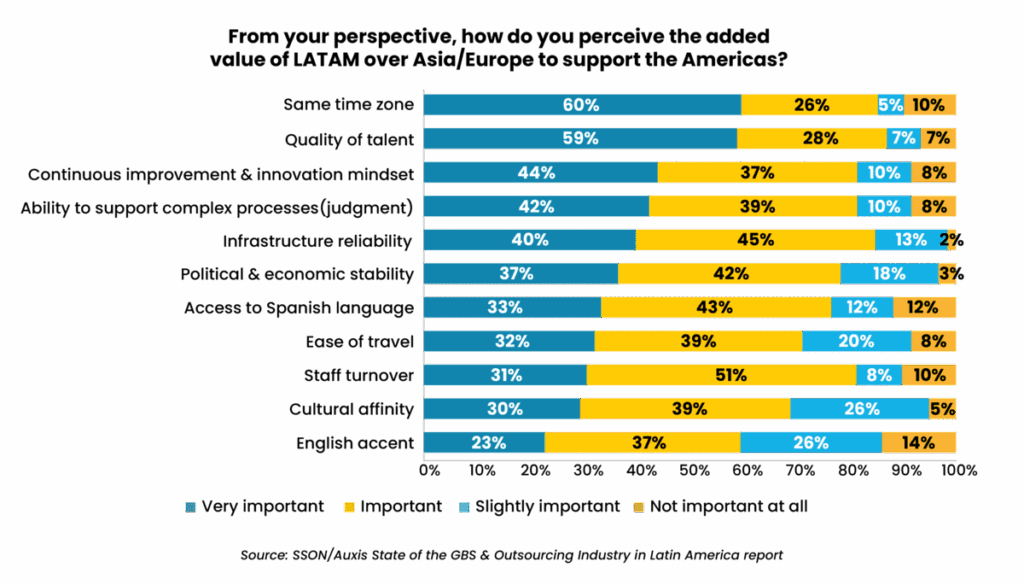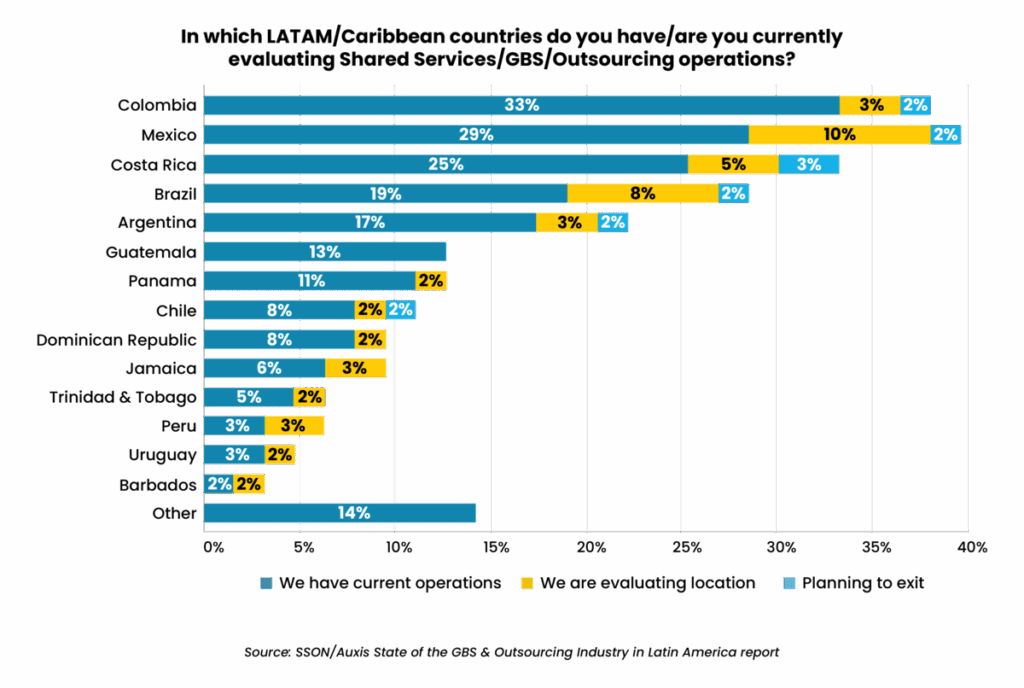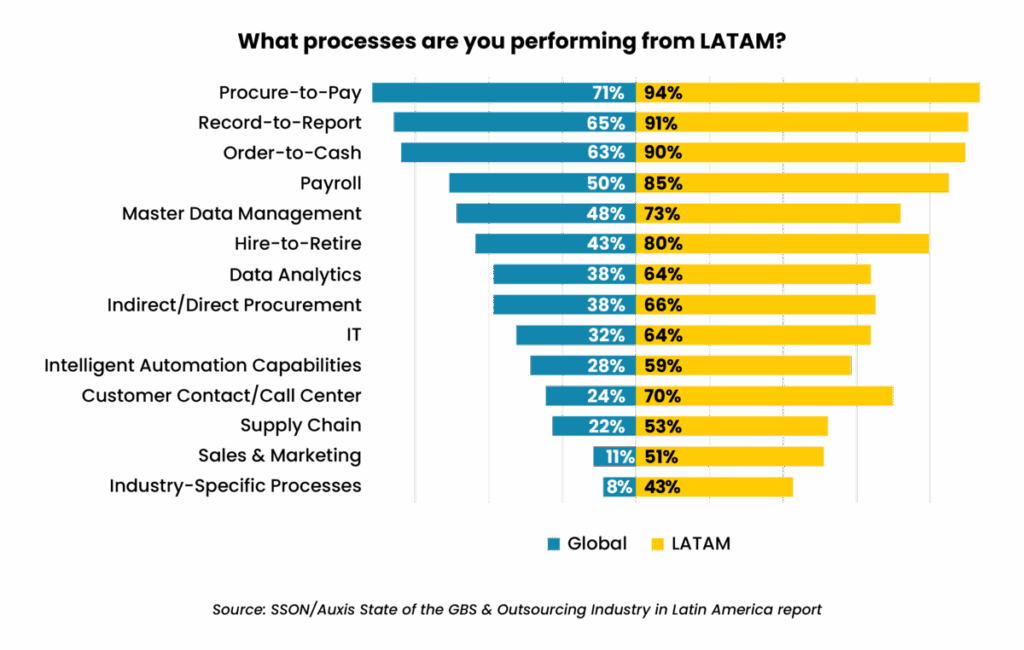In brief:
- What is nearshoring? Nearshoring refers to outsourcing business functions to nearby regions – such as Latin America for the U.S. – rather than far-off offshoring destinations like Asia. This model offers better time zone alignment, cultural affinity, and access to top talent.
- While offshoring models often prioritize labor cost savings, nearshoring combines cost benefits with strategic advantages that include greater agility, real-time collaboration, and a better ability to support complex processes.
- Nearshoring to Latin America is gaining momentum as the preferred outsourcing approach for the U.S. – especially for complex, judgment-intensive, or time-sensitive processes – with 90% of organizations already operating in LATAM or planning to open operations within the next three years.
As macroeconomic pressures and geopolitical uncertainty intensify, many U.S. companies are reevaluating their approach to global outsourcing. While traditional Asia-based models offer low labor costs that can offer benefits for high-volume, transactional processes, they also come with other challenges including distant time zones, cultural and language barriers, high turnover rates, and difficulty supporting more complex tasks.
As a result, executives are asking a fundamental question: What is nearshoring, and why is it becoming a preferred strategy for reducing costs while also improving efficiency and access to top talent?
The answer lies in the shifting priorities of today’s business landscape. Only 34% of enterprises now rank the ability to cut costs as their main outsourcing driver, down from 70% in 2020 (Deloitte’s 2024 Global Outsourcing Survey). Instead, priorities have shifted toward nearshoring, meaning that companies are seeking strategic outsourcing relationships that drive talent access, accelerate digital transformation, improve customer experiences, and successfully deliver more judgment-intensive processes.
In a market overview, Everest Group forecasts 17% growth in finance and accounting outsourcing to Latin America (LATAM) by 2026 as demand shifts from low-cost transactional work to strategic partnerships. In fact, Tholons predicts that 50% of companies will adopt hybrid sourcing models by 2026 that include nearshoring, driven by the need for greater agility and resilience (2025 Top 10 GCC/GBS Trends Report).
This blog will explore the core elements of nearshoring, clarify the nearshoring definition, and highlight why this outsourcing model is gaining momentum among so many businesses across the world.
What is nearshore outsourcing?
Nearshoring is a business strategy that involves outsourcing services to nearby countries that are geographically close to your home base, typically within the same or a similar time zone. For companies based in the U.S., this often involves shifting work to Latin America instead of distant regions like Asia.
As a strategic alternative to offshore outsourcing, the benefits of nearshoring include lower labor costs, faster response times, and improved team collaboration. By operating closer to home, companies gain better oversight, reduce communication barriers, and drive more agile service delivery.
How is nearshore outsourcing different from offshoring and onshoring?
Offshoring refers to outsourcing business functions to distant countries, with India and the Philippines among the most common destinations. These locations offer low labor costs and large talent pools, but challenges like opposite time zones, language barriers, high employee turnover, and limited operational transparency due to “black box” service models can significantly hinder responsiveness, collaboration, and productivity.
In contrast, onshoring involves outsourcing within the same country as your home base, such as a U.S. company contracting services to a domestic provider. While this model offers stronger control, cultural alignment, and easier communication, onshore outsourcing also comes with significantly higher labor costs and more limited scalability.
Nearshoring bridges the gap between these two models by combining the geographical proximity and alignment of onshoring with cost efficiency similar to offshoring, delivering a more balanced and agile outsourcing solution. Understanding the nearshore meaning helps clarify why many companies now see nearshoring as an effective middle ground.
What are the advantages of nearshoring for U.S. companies?
As labor shortages persist and service delivery demands become more complex, nearshoring has become a smart alternative for U.S. businesses seeking more than just cost savings. Ninety percent of enterprise and shared services leaders already operate in Latin America or plan to open operations there in the next three years, according to the 2024 State of the GBS and Outsourcing Industry in Latin America report by the Shared Services & Outsourcing Network (SSON) and Auxis.
With 84% of LATAM shared services already supporting North America – up from just 44% in 2016 – organizations are increasingly moving work closer to home to create a seamless extension of their internal teams.
Recently, there has also been a growing trend toward companies leveraging Latin America to complement or expand existing operations in Asia or Europe – whether that means accessing nearshore advantages to deliver higher-value processes or diversifying their shared services portfolio geographically to mitigate risk. Today, 65% of enterprise and shared services leaders evaluating LATAM are looking to add to existing operations in other countries, the SSON/Auxis report found.
Understanding the nearshoring definition helps explain why this model is rising in popularity across industries.
Let’s explore the top 5 reasons North American companies are shifting business operations to Latin America
- Real-time collaboration
Time zone alignment with the U.S. enables faster decision-making, more responsive service, and stronger day-to-day teamwork. Some 60% of survey respondents ranked time zone compatibility as the #1 (“very important”) nearshore advantage on the SSON/Auxis report. - Access to high-quality, cost-effective talent
As “access to talent” outpaces cost savings as the #1 outsourcing driver, Latin America offers deep talent pools with strong English proficiency and extensive expertise across core business functions like finance, IT, and HR – while still delivering average labor arbitrage of 30-50%. Nearly 90% of shared services and enterprise leaders ranked talent quality as a top reason to choose LATAM over Asia or Europe. - Continuous improvement & innovation mindset
Unlike traditional offshore providers with value propositions based solely on cost, nearshore partners in LATAM emphasize innovation and process optimization. Their greatest value stems from balancing cost efficiency with operational excellence – bringing the flexibility to tailor solutions to business needs, optimize operations, and drive continuous improvement. For example, LATAM shared services organizations lead other regions in adopting critical technologies like automation and analytics, the SSON/Auxis report found. - Support for complex processes
Latin America’s cultural alignment, highly skilled workforce, strong English proficiency, and time zone compatibility make it ideal for handling judgment-based, high-value processes in addition to transactional work. More than 80% of business leaders cited LATAM’s better ability to support complex processes as a key advantage over offshore regions, the SSON/Auxis report found – empowering real-time collaboration, decision-making at every level, and more flexible service delivery that reduces reliance on internal teams. - Reliable infrastructure for remote work
While Asian destinations like India and the Philippines have made significant improvements to their infrastructure since the pandemic, they continue to present challenges for the hybrid or remote work models that shared services workers now demand, states Nordlayer’s latest Global Remote Work Index. Latin America’s more stable digital infrastructure supports quality service delivery, with many nearshore countries outranking traditional offshore outsourcing destinations in remote work readiness on the Nordlayer report. This reliability supports hybrid work models and seamless service across time zones, a key factor in choosing locations that align with modern workforce needs.

What are the top nearshoring locations?
When evaluating nearshore outsourcing opportunities, U.S. organizations consistently turn to Latin America for its strong talent, nonexistent or minimal time zone differences, and mature shared services capabilities. But which countries are leading the charge?
According to the SSON/Auxis report, three countries stand out as the top nearshore outsourcing destinations. While Brazil also appears to host a fast-growing shared services industry, it is worth noting that a big percentage supports its domestic market, rather than the rest of LATAM or North America. The reasons? Its Portuguese language, complex labor and tax laws, and higher labor costs, among others.
Here are the nearshore “Big Three” markets for supporting multi-function shared services operations:
Colombia
Colombia has emerged as a leading shared services market in recent years, ranking as a top destination globally and as the most financially attractive nearshore destination on Kearney’s latest Global Services Location Index. Colombia’s strong government investment in key educational areas like finance and IT combine with competitive labor costs to make it a desirable choice for both transactional and complex work. Its growing tech ecosystem has also become a hotbed for organizations looking to outsource software development or other tech capabilities. Colombia ranks second in LATAM for skilled talent availability, offering multiple cities that can support sizable shared services operations.
Mexico
With close geographical proximity to the U.S., an extensive bilingual workforce, and robust infrastructure, Mexico is a top pick for organizations both operating in and evaluating Latin America. It ranks #1 among companies considering where to expand next on the SSON/Auxis report, reinforced by its inclusion among the three most preferred shared services locations globally on Deloitte’s 2025 Global Business Services (GBS) Survey due to technology and talent availability, scalability, and competitive cost.
Costa Rica
Known for its highly educated workforce, political stability, outstanding English proficiency, and deep experience with U.S.-based clients, Costa Rica remains a premium destination for high-value, knowledge-based processes. Considered the most mature shared services market in LATAM due to the 350+ multinational companies operating within its borders, Costa Rica ranks as a top 10 destination globally on Deloitte’s latest Global Shared Services and Outsourcing Survey.

What business processes are ideal for nearshoring?
As nearshoring grows in popularity, companies are discovering that Latin America isn’t just suited for basic and transactional work. Rather, it’s excelling across the full spectrum of business processes.
In fact, the SSON/Auxis report found that Latin America’s shared services organizations are already delivering business functions at a greater scale than their global counterparts. This includes both traditional areas like accounts payable and accounts receivable, and more complex functions like IT, analytics, intelligent automation, HR, supply chain, and software development outsourcing, thus showcasing the true nearshore meaning for modern enterprises.
What sets the region apart? The reasons sound familiar. Cultural similarities, highly skilled talent, English fluency, and real-time collaboration with U.S. teams make nearshore locations uniquely capable of supporting advanced, time-sensitive, and high-touch processes, all of which are areas where offshoring to distant countries often falls short.
This ability to handle both high-volume transactions and knowledge-based work is a key reason nearshoring to LATAM continues to gain traction among North American enterprises.

Why Auxis: Discover the real nearshoring definition with a trusted pioneer
For many years, outsourcing was defined by a single priority: cost savings. Traditional solutions delivered value for transactional work, but often at the expense of agility, communication, and collaboration. Today, organizations expect more while demanding strategic partners who can drive innovation, scalability, and real business outcomes.
That is where Auxis redefines the nearshore meaning.
A recognized pioneer in nearshore outsourcing, Auxis has spent nearly 30 years helping organizations achieve operational excellence through smarter, more agile service delivery. Named to IAOP’s Global Outsourcing 100 list for ten consecutive years and honored as a top outsourcing company globally by Everest Group and ISG, Auxis continues to lead the market with a multi-country delivery platform that leverages all the benefits of Costa Rica, Colombia, and Mexico – the top three nearshore destinations for U.S. companies.
Auxis is also a leader in next-gen capabilities. As a UiPath Platinum Partner, Agentic Automation Fast Track Parner, and Americas Partner of the Year, Auxis has made AI and automation a cornerstone of its outsourcing approach, helping clients unlock business practices that bring new levels of efficiency, insight, and performance.
Whether you’re looking to streamline business operations, scale smarter, or evolve your global delivery model, Auxis provides the real nearshoring meaning: a partner that delivers more than savings by delivering results.
Ready to learn more about nearshore outsourcing benefits? Schedule a consultation with our nearshore experts today! You can also download our reports, Nearshore vs. Offshore: Navigating the Hidden Hassles of Outsourcing to Asia and 2024 State of the GBS & Outsourcing Industry in Latin America to learn more about the opportunities and challenges of nearshore and offshore markets.




